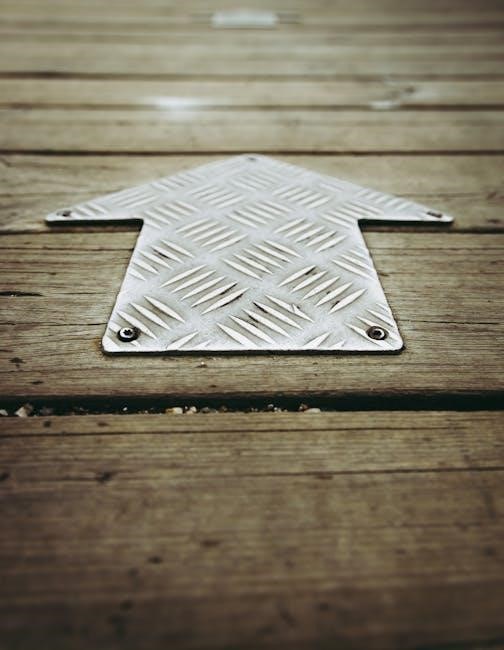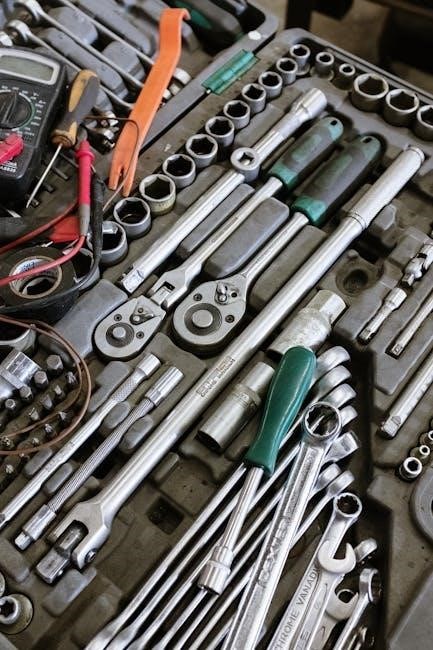The Kreg Jig Screw Length Guide is an essential tool for ensuring accurate screw selection in pocket hole joinery. It helps determine the correct screw length based on wood thickness and joint type, avoiding common issues like screw protrusion. This guide is a must-have for both beginners and experienced woodworkers, providing a reliable resource for precise and consistent results in various woodworking projects. By following the guide, users can achieve professional-grade joint strength and durability with ease.
1.1 Overview of the Kreg Jig System
The Kreg Jig System is a revolutionary pocket-hole joinery solution designed to simplify woodworking projects. Invented by Craig Sommerfeld, it guides drills at precise angles and depths to create uniform pocket holes. This system ensures strong, durable joints in various materials. The Kreg Jig consists of a sturdy base, drill guides, and a depth collar, making it versatile for projects ranging from furniture to cabinets. Its adaptability and ease of use make it a favorite among both hobbyists and professionals. By streamlining the joinery process, the Kreg Jig enhances productivity and accuracy, allowing users to focus on creativity and craftsmanship. This system is a cornerstone of modern woodworking, offering reliable results for any skill level.
1.2 Importance of Screw Length in Pocket Hole Joinery
The correct screw length is critical in pocket hole joinery to ensure strong, durable joints. A screw that is too short may not hold the joint securely, while one that is too long can protrude from the material, weakening the structure. Proper screw length prevents damage to the wood and ensures the joint’s integrity. Using the Kreg Jig Screw Length Guide helps woodworkers avoid common mistakes, such as incorrect screw selection, by providing precise recommendations based on material thickness and joint type. This guide is essential for achieving professional-grade results, as it eliminates guesswork and guarantees optimal joint strength. Accurate screw length selection is a cornerstone of successful pocket hole joinery, making the guide an indispensable tool for all woodworking projects.

Understanding the Kreg Jig Screw Length Guide
The Kreg Jig Screw Length Guide is a tool designed to help users select the correct screw length for their pocket hole joinery projects. It ensures joint strength and durability by providing precise recommendations based on wood thickness and joint type, making it an invaluable resource for woodworkers of all skill levels.
2.1 What is the Kreg Jig?
The Kreg Jig is a revolutionary woodworking tool designed to create precise pocket holes for joinery. Invented by Craig Sommerfeld, it guides the drill bit at the perfect angle and depth, ensuring uniform holes for strong joints. The jig is essential for pocket-hole joinery, a technique that hides screws inside the wood, creating durable and invisible connections. Its adjustable settings accommodate various wood thicknesses, making it versatile for projects like furniture, cabinets, and framing. Key components include the drill guide, depth collar, and clamping system. By using the Kreg Jig, woodworkers achieve professional-grade results with ease, making it a must-have tool for both beginners and experienced craftsmen. Its simplicity and effectiveness have made it a cornerstone in modern woodworking.
2.2 Key Components of the Kreg Jig
The Kreg Jig consists of several essential components that ensure precise pocket hole creation. The drill guide aligns the drill bit at the correct angle, while the depth collar sets the exact depth for screw insertion. The clamping system securely holds the jig to the workpiece, preventing movement during drilling. Additionally, the screw length guide helps determine the appropriate screw size based on material thickness. Some models also feature a detachable drill guide for added versatility. These components work together to deliver consistent, professional-grade results in pocket hole joinery. Understanding each part is crucial for maximizing the jig’s potential and achieving strong, durable joints in woodworking projects.

Choosing the Right Screw Length
Selecting the correct screw length is vital for strong joints. Measure wood thickness and use the Kreg Screw Selector Tool or guide for accurate selection. Consider joint type and material to ensure proper fit and avoid protrusion, ensuring durable and professional results in woodworking projects.
3.1 Determining Wood Thickness for Screw Selection
Determining wood thickness is the first step in selecting the right screw length for pocket hole joinery. Measure the thickest board in your project to ensure the screw doesn’t protrude. Use the Kreg Screw Selector Tool or a screw length guide to match the thickness with the correct screw size. For example, a 1-1/2″ thick board typically requires a 2-1/2″ screw. Always test your settings on scrap wood to confirm the screw length and jig setup. This step ensures strong, flush joints and prevents errors like screw protrusion. Accurate wood thickness measurement is crucial for achieving professional-grade results in your woodworking projects. Proper setup guarantees durability and a clean finish, making it a foundational step in the process.
3.2 Understanding Different Joint Types and Screw Requirements
Understanding joint types is crucial for selecting the correct screw length and ensuring strong, durable connections. Common joints include butt, miter, and edge-to-edge joints, each requiring specific screw lengths. For example, miter joints may need shorter screws to avoid protrusion, while edge-to-edge joints often require longer screws for optimal strength. The Kreg Screw Selector Tool simplifies this process by recommending screw lengths based on joint type and wood thickness. Proper screw selection ensures flush joints and prevents weakening the joint. Always consider the joint type when using the guide to achieve professional-grade results. Testing settings on scrap wood before final assembly is recommended to confirm accuracy and avoid costly mistakes. This step ensures your project’s longevity and structural integrity.

Using the Kreg Screw Selector Tool
The Kreg Screw Selector Tool simplifies choosing the right screw length by inputting wood thickness and joint type, ensuring precise and consistent results for all projects.
4.1 Features of the Kreg Screw Selector Tool
The Kreg Screw Selector Tool offers a user-friendly interface designed to simplify screw selection. Key features include input fields for wood thickness and joint type, ensuring accurate screw length recommendations. The tool automatically calculates the optimal screw size based on the provided measurements, reducing guesswork and errors. Additionally, it supports various materials and project requirements, making it versatile for different woodworking scenarios. The tool also provides clear, step-by-step instructions, enhancing ease of use for both beginners and experienced woodworkers; By leveraging this tool, users can streamline their workflow, ensuring precision and consistency in their pocket hole joinery projects. Its accessibility and reliability make it an indispensable resource for achieving professional-grade results.
4.2 How to Use the Screw Selector for Accurate Results
To use the Kreg Screw Selector Tool effectively, start by inputting the thickness of your materials and the type of joint you’re creating. The tool will instantly provide the recommended screw length and jig settings. For precise results, ensure your measurements are accurate and reflect the specific requirements of your project. Always test the suggested screw and jig combination on scrap material before applying it to your final piece. This step helps prevent errors and ensures a strong, durable joint. By following these guidelines, you can maximize the tool’s functionality and achieve consistent, professional-grade outcomes in your woodworking projects. Proper use of the Screw Selector Tool guarantees efficiency and accuracy, making it an invaluable asset for any woodworker.

Setting Up Your Kreg Jig
Setting up your Kreg Jig involves adjusting the jig to match your material thickness and calibrating the drill bit for precise pocket holes. Always test settings on scrap wood to ensure accuracy and proper screw alignment before starting your project. This step ensures consistent results and prevents costly mistakes. Proper setup is key to achieving strong, durable joints in your woodworking projects.
5.1 Adjusting the Jig for Proper Screw Depth
Adjusting the Kreg Jig for proper screw depth is crucial for ensuring accurate pocket holes and secure joints. Start by measuring the thickness of your material and referring to the screw length guide to determine the correct depth setting. Use the jig’s adjustment knob to set the depth collar on the drill bit to the recommended position. This ensures that screws will not protrude from the back of the material, which could weaken the joint or damage the surrounding wood. Always test the setup on scrap wood before working on your actual project to confirm proper alignment and depth. Proper adjustment guarantees consistent results and prevents costly mistakes.
5.2 Calibrating the Drill Bit for Consistent Results
Calibrating the drill bit is essential for achieving consistent results with your Kreg Jig. Start by ensuring the drill bit is properly seated in the jig’s drill guide. Adjust the depth collar on the drill bit to match the thickness of your material, as specified by the screw length guide. Use a caliper or ruler to verify the collar’s position for accuracy. Next, drill a test pocket hole in scrap wood to check the depth and angle of the hole. If necessary, fine-tune the collar and repeat the test until the hole meets your requirements. Proper calibration ensures that screws sit flush and joints are strong. Regularly checking and recalibrating the drill bit prevents misaligned holes and enhances the overall quality of your projects. Consistent results rely on precise calibration and attention to detail.

Common Mistakes to Avoid
Common mistakes include incorrect jig settings and using wrong screw lengths, leading to weak joints. Always test settings on scrap wood first to avoid costly errors.
6.1 Incorrect Jig Settings and Their Consequences
Incorrect jig settings are a common mistake that can lead to poor joint quality. If the jig is not adjusted properly for the material thickness, it can result in uneven drilling or screws that protrude from the surface. This not only weakens the joint but also compromises the appearance of the project. Using the wrong drill bit or failing to calibrate the jig can exacerbate these issues. Additionally, neglecting to test settings on scrap wood before working on the actual project can lead to costly errors. Ensuring accurate jig settings is critical to achieving strong, professional-grade joints. Always refer to the Kreg Screw Length Guide and double-check settings before drilling.
6.2 Avoiding Screw Protrusion and Ensuring Joint Integrity
Screw protrusion is a critical issue in pocket hole joinery, as it can weaken the joint and damage the workpiece. To avoid this, always use the correct screw length based on the Kreg Jig Screw Length Guide. Proper jig settings and accurate material thickness measurements are essential. Testing settings on scrap wood ensures screws sit flush within the pocket hole. Over-tightening screws can also cause protrusion, so apply even pressure during assembly. Ensuring joint integrity involves using the right screw type and maintaining consistent drilling depth. Regular calibration of the drill bit and jig alignment further prevents errors. By following these guidelines, you can achieve joints that are both secure and visually appealing, enhancing the overall quality of your projects.
Practical Applications of the Screw Length Guide
The Kreg Jig Screw Length Guide is invaluable for various woodworking projects, ensuring precise screw selection and enhancing accuracy in cabinet building, furniture making, and general woodworking tasks.
7.1 Building Cabinets and Furniture with Precision
Building cabinets and furniture requires exact measurements and secure joints, making the Kreg Jig Screw Length Guide indispensable. By ensuring the correct screw length for varying wood thicknesses, it prevents issues like screw protrusion, enhancing durability. The guide simplifies project planning, allowing woodworkers to focus on design and craftsmanship. Whether constructing a kitchen cabinet or a custom bookshelf, the guide ensures each joint is strong and long-lasting, meeting professional standards. This precision is crucial for load-bearing furniture, guaranteeing stability and safety. With the Kreg Jig Screw Length Guide, even complex projects become manageable, delivering flawless results every time.
7.2 Using the Guide for Various Woodworking Projects
The Kreg Jig Screw Length Guide is versatile, catering to a wide range of woodworking projects, from simple DIY tasks to intricate custom designs. Whether building a birdhouse, creating decorative wall art, or crafting a dining table, the guide ensures accurate screw length selection. It is particularly useful for projects requiring precise joint alignment, such as shelving units or outdoor structures. The guide’s adaptability allows woodworkers to tackle diverse materials and thicknesses, ensuring robust and durable joints. By eliminating guesswork, it saves time and reduces errors, making it an invaluable tool for both casual and advanced woodworking endeavors. Its universal application makes it a must-have for any project requiring pocket hole joinery.

Advanced Techniques with the Kreg Jig
Advanced techniques with the Kreg Jig involve optimizing settings for complex projects, enhancing joint strength, and troubleshooting common issues. These methods refine your woodworking skills and project outcomes.
8.1 Enhancing Joint Strength with Proper Screw Selection
Proper screw selection is critical for maximizing joint strength in pocket hole joinery. Using screws that are too short can lead to weak joints, while screws that are too long may protrude, causing damage. The Kreg Jig Screw Length Guide helps ensure you choose the optimal screw length based on wood thickness and joint type. For thicker materials, longer screws provide better stability, while shorter screws are suitable for thinner woods. Additionally, selecting the right screw type, such as coarse or fine thread, depends on the material being used. Always test your screw and jig settings on scrap wood to confirm proper fit and joint integrity. This step ensures your projects are durable and professional-grade.
8.2 Troubleshooting Common Issues in Pocket Hole Joinery
Troubleshooting common issues in pocket hole joinery can save time and ensure project success. One frequent problem is screws protruding from the back of the material, which can be resolved by adjusting the jig’s depth setting or using shorter screws. Another issue is joint misalignment, often caused by improper clamp placement or uneven drilling. To fix this, ensure the jig is securely clamped and the drill bit is properly calibrated. Splintering of the wood can occur if the drill bit is dull or if the material is too thin; using a sharp bit and appropriate screw lengths helps prevent this. Testing screw and jig settings on scrap wood before starting your project is a reliable way to identify and resolve potential issues early. This step ensures a stronger, more professional finish in your woodworking projects.

Kreg Jig Accessories and Complementary Tools
Essential accessories like the Kreg Screw Selector Tool, drill bits, and clamps enhance the jig’s performance, ensuring precise and efficient pocket hole joinery. These tools optimize workflow and project outcomes.
9.1 Must-Have Accessories for Optimal Performance
Several accessories are crucial for maximizing the potential of your Kreg Jig. The Kreg Screw Selector Tool simplifies choosing the right screw length and type, ensuring compatibility with your project’s specific needs. A high-quality drill bit is essential for creating precise pocket holes, while clamps help maintain stability during drilling. Additionally, the Kreg Jig Settings Calculator offers a convenient way to determine the correct jig and drill bit settings for various wood thicknesses. These tools collectively enhance accuracy, efficiency, and the overall quality of your woodworking projects. Investing in these accessories ensures that your Kreg Jig performs at its best, delivering professional-grade results consistently.
9.2 How These Tools Enhance Your Woodworking Experience
The Kreg Jig accessories significantly enhance woodworking efficiency and precision. The Screw Selector Tool streamlines screw selection, saving time and reducing errors. High-quality drill bits ensure clean, accurate pocket holes, while clamps provide stability for consistent results. The Kreg Jig Settings Calculator eliminates guesswork, offering precise adjustments for various wood thicknesses. Together, these tools minimize trial and error, allowing for smoother workflows and professional-grade outcomes. They empower woodworkers to focus on creativity and craftsmanship, knowing their joints are strong and reliable. By integrating these tools, you elevate your woodworking process, achieving consistent success in all your projects.

Safety Tips When Using the Kreg Jig
Always wear safety goggles, ensure proper jig setup, use the correct drill bit, test on scrap wood, and keep loose clothing tied back while operating.
10.1 Essential Safety Precautions for Beginners
When using the Kreg Jig, beginners should always wear safety goggles to protect their eyes from debris. Ensure the jig is securely clamped to a stable work surface to prevent movement during drilling. Use the correct drill bit size and type recommended by Kreg to avoid accidents. Keep loose clothing and long hair tied back to avoid entanglement with the drill. Always test settings and screws on scrap wood before working on your actual project. Maintain a clean and well-lit workspace to reduce hazards. Familiarize yourself with the tool’s operation and follow the manufacturer’s guidelines. Never leave the drill unattended while in operation. By following these precautions, you can ensure a safe and successful woodworking experience with the Kreg Jig.
10.2 Maintaining a Safe Workshop Environment
To maintain a safe workshop environment, ensure proper lighting to clearly see your tools and materials. Keep the floor clear of clutter to prevent tripping hazards and ensure easy access to emergency exits. Store tools and materials in designated areas to avoid accidental damage or misuse. Use proper ventilation, especially when working with wood and power tools, to reduce dust and fume exposure. Regularly inspect tools and equipment for damage or wear, and perform routine maintenance to ensure they function correctly. Keep a fire extinguisher and first aid kit nearby for emergencies. A clean and organized workspace not only enhances safety but also improves efficiency and focus while using the Kreg Jig.
The Kreg Jig Screw Length Guide is indispensable for accurate screw selection, ensuring joint integrity and avoiding common mistakes. Mastering it enhances your woodworking projects’ quality and durability.
11.1 Summary of Key Points for Successful Screw Length Selection
Mastering the Kreg Jig Screw Length Guide ensures precise screw selection, enhancing joint strength and project durability. Key points include measuring wood thickness accurately, using the Screw Selector Tool for specific joint types, and testing settings on scrap material to avoid protrusion. Proper jig setup and drill bit calibration are crucial for consistent results. Understanding the relationship between screw length and material thickness prevents common errors. By following these guidelines, woodworkers can achieve professional-grade outcomes, whether building cabinets or crafting intricate furniture. Regular practice and adherence to the guide’s recommendations will elevate your woodworking skills and confidence in pocket hole joinery.
11.2 Encouragement to Practice and Master the Guide
Mastering the Kreg Jig Screw Length Guide is a skill that takes time and effort but yields exceptional results. Encourage yourself to practice regularly, starting with simple projects and gradually tackling more complex ones. Testing screw lengths on scrap wood builds confidence and ensures accuracy. Remember, consistent practice leads to stronger joints and a more professional finish. Don’t hesitate to refer back to the guide—it’s a valuable resource for refining your technique. As you progress, you’ll become more intuitive about screw selection, enhancing your overall woodworking experience. Embrace the process, stay patient, and celebrate small improvements. With dedication, you’ll master the guide and take your projects to the next level, achieving precision and durability every time.

Additional Resources for Further Learning
Explore Kreg’s official website for detailed guides, video tutorials, and their Screw Selector tool. Join woodworking forums and communities for expert advice and shared experiences. Utilize online calculators and charts for precise settings, ensuring optimal results in your projects. These resources provide comprehensive support for mastering the Kreg Jig Screw Length Guide and enhancing your woodworking skills.
12.1 Recommended Reading and Tutorials
For in-depth learning, explore Kreg’s official website, which offers comprehensive guides, tutorials, and their innovative Screw Selector tool. Online forums like Sawmill Creek and Reddit’s woodworking communities provide valuable insights and troubleshooting tips. YouTube channels dedicated to woodworking feature detailed Kreg Jig tutorials, covering setup, screw selection, and project applications. Additionally, Kreg’s blog and FAQ section address common questions and advanced techniques. Books on pocket hole joinery, such as those by Craig Sommerfeld, delve into the fundamentals and beyond. These resources collectively provide a wealth of knowledge to enhance your skills and mastery of the Kreg Jig Screw Length Guide. Utilize them to refine your techniques and tackle complex projects with confidence.
12.2 Community Forums and Expert Advice
Engaging with community forums and seeking expert advice can significantly enhance your understanding of the Kreg Jig Screw Length Guide. Platforms like Reddit’s r/woodworking, Sawmill Creek, and Facebook woodworking groups offer valuable discussions and tips from experienced users. Additionally, Kreg’s official forums and technical support team provide direct assistance and troubleshooting. Expert woodworkers often share their insights on YouTube and blogs, offering practical advice on optimizing screw selection and jig settings. These communities are invaluable for addressing specific challenges and learning advanced techniques. By connecting with fellow woodworkers and experts, you can refine your skills and overcome common obstacles, ensuring your projects achieve professional-grade results. Community feedback is a powerful tool for continuous improvement in pocket hole joinery.


